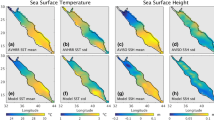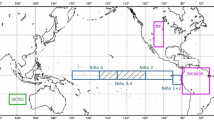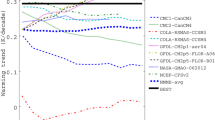Abstract
A method to initialize an ensemble, introduced by Evensen (Physica, D 77:108–129, 1994a; J Geophys Res 99(C5):10143–10162, 1994b; Ocean Dynamics 53:343–367, 2003), was applied to the Ocean General Circulation Model (OGCM) HYbrid Coordinate Ocean Model (HYCOM) for the Pacific Ocean. Taking advantage of the hybrid coordinates, an initial ensemble is created by first perturbing the layer interfaces and then running the model for a spin-up period of 1 month forced by randomly perturbed atmospheric forcing fields. In addition to the perturbations of layer interfaces, we implemented perturbations of the mixed layer temperatures. In this paper, we investigate the quality of the initial ensemble generated by this scheme and the influence of the horizontal decorrelation scale and vertical correlation on the statistics of the resulting ensemble. We performed six ensemble generation experiments with different combinations of horizontal decorrelation scales and with/without perturbations in the mixed layer. The resulting six sets of initial ensembles are then analyzed in terms of sustainability of the ensemble spread and realism of the correlation patterns. The ensemble spreads are validated against the difference between model and observations after 20 years of free run. The correlation patterns of six sets of ensemble are compared to each other. This study shows that the ensemble generation scheme can effectively generate an initial ensemble whose spread is consistent with the observed errors. The correlation pattern of the ensemble also exhibits realistic features. The addition of mixed layer perturbations improves both the spread and correlation. Some limitations of the ensemble generation scheme are also discussed. We found that the vertical shift of isopycnal coordinates provokes unrealistically large deviations in shallow layers near the islands of the West Pacific. A simple correction circumvents the problem.











Similar content being viewed by others
Notes
The covariance of a pair of points depends only on the distance that separates them.
Abbreviations
- EnKF:
-
Ensemble Kalman Filter
- KF:
-
Kalman filter
- KPZ:
-
Kardar–Parisi–Zhang
- HYCOM:
-
HYbrid Coordinate Ocean Model
- MICOM:
-
Miami Isopycnic Coordinate Ocean Model
- GDEM:
-
Generalized Digital Environmental Model
- GEBCO:
-
General Bathymetric Chart Of The Oceans Model
- ECMWF:
-
European Center for Medium-range Weather Forecasting
- SVD:
-
singular value decomposition
- OISST:
-
optimum interpolation sea surface temperature
- TOGA-COARE:
-
Tropical Ocean Global Atmosphere Coupled Ocean Atmosphere Response Experiment
- TAO:
-
Tropical Atmosphere/Ocean
- SSH:
-
sea surface height
- CLS:
-
Collecte Localisation Satellites
- ECC:
-
equatorial countercurrent
- NEC:
-
north equatorial current
- SEC:
-
south equatorial current
References
Alves O, Robert C (2005) Tropical Pacific Ocean model error covariances from Monte Carlo simulations. Q J R Meteorol Soc 131:3643–3658
Bentsen M, Evensen G, Drange H, Jenkins AD (1999) Coordinate transform on a sphere using conformal mapping. Mon Weather Rev 127:2733–2740
Bertino L, Evensen G, Wackernagel H (2003) Sequential data assimilation techniques in oceanography. Int Stat Rev 71:223–241
Bleck R (2002) An oceanic general circulation model framed in hybrid isopycnic-Cartesian coordinates. Ocean Model 4:55–88
Bleck R, Smith LT (1990) A wind-driven isopycnic coordinate model of the north and equatorial Atlantic Ocean: 1 Model development and supporting experiments. J Geophys Res 95:3273–3285
Brusdal A, Brankart JM, Halberstadt G, Evensen G, Brasseur P, van Leeuwen PJ, Dombrowsky E, Verron J (2003) A demonstration of ensemble-based assimilation methods with a layered OGCM from the perspective of operational ocean forecasting systems. J Mar Syst 40–41:253–289
Burgers G, van Leeuwen PJ, Evensen G (1998) Analysis scheme in the Ensemble Kalman Filter. Mon Weather Rev 126:1719–1724
Dee DP, da Silva AM (1998) Data assimilation in the presence of forecast bias. Q J R Meteorol Soc 124:239–295
Evensen G (1994a) Inverse methods and data assimilation in nonlinear ocean models. Physica, D 77:108–129
Evensen G (1994b) Sequential data assimilation with a nonlinear quasi-geostrophic model using Monte Carlo methods to forecast error statistics. J Geophys Res 99(C5):10143–10162
Evensen G (1992) Using the Extended Kalman Filter with a Multilayer Quasi-Geostrophic Ocean Model J Geophys Res, (97), pp. 17,905–17,924
Evensen G (2003) The ensemble Kalman filter: theoretical formulation and practical implementation. Ocean Dynamics 53:343–367
Evensen G (2004) Sampling strategies and square root analysis schemes for the EnKF. Ocean Dynamics 54:539–560
Evensen G, Van Leeuwen PJ (1996) Assimilation of Geosat Altimeter data for the Agulhas current using the Ensemble Kalman Filter with a quasi-geostrophic model. Mon Weather Rev 124:85–96
Fu WW, Zhou GQ, Wang HJ (2004) Ocean data assimilation with background error covariance derived from OGCM outputs. Adv Atmos Sci 21:181–192
Hamill TM, Whitaker JS, Snyder, C (2001) Distance dependent filtering of background error covariance estimates in an ensemble Kalman filter. Mon Weather Rev 129:2776–2790
Hamill TM, Whitaker JS (2005) Accounting for the error due to unresolved scales in ensemble data assimilation: a comparison of different approaches. Mon Weather Rev 133:3132–3147
Haugen VE, Evenson G (2002) Assimilation of SLA and SST data into an OGCM for the Indian ocean. Ocean Dynamics 52:133–151
Houtekamer PL, Mitchell HL (2001) A sequential ensemble Kalman filter for atmospheric data assimilation. Mon Weather Rev 129:123–137
Houtekamer PL, Mitchell HL, Pellerin G, Buehner M, Charron M, Spacek L, Hansen B (2005) Atmospheric data assimilation with an ensemble Kalman filter: results with real observation. Mon Weather Rev 133:604–620
Kalnay E, Li H, Miyoshi T, Yang SC, Ballabrera-Poy J (2006) 4D-Var or ensemble Kalman filter? Available at http://www.atmos.umd.edu/~ekalnay/4DVarOrEnKFKalnaySubm.pdf
Kara AB, Hurlburt HE, Wallcraft AJ, Bourassa MA (2005) Black sea mixed layer sensitivity to various wind and thermal forcing products on climatological time scales. J Climate 18:5266–5293
Keppenne CL, Rienecker MM (2002) Initial testing of a massively parallel ensemble Kalman filter with the Poseidon isopycnal ocean general circulation model. Mon Weather Rev 130:2951–2965
Keppenne CL, Rienecker MM (2003) Assimilation of temperature into and isopycnal ocean general circulation model using a parallel ensemble Kalman filter. J Marine Sys 40-41, 363–380
Lantuejoul C (2002) Geostatistical simulations: methods and algorithms. Springer, Berlin
Legates DR, Willmott CJ (1990) Mean seasonal and spatial variability in gauge-corrected, global precipitation. Int J Climatol 10:111–127
Leeuwenburgh O (2005) Assimilation of along-track altimeter data in the tropical Pacific region of a global OGCM ensemble. Q J R Meteorol Soc 131:2455–2472
Leeuwenburgh O (2007) Validation of an EnKF system for OGCM initialization assimilating temperature, salinity, and surface height measurements. Mon Weather Rev 135:125–139
Lisæter KA, Rosanova J, Evensen G (2003) Assimilation of ice concentration in a coupled ice–ocean model, using the ensemble Kalman filter. Ocean Dynamics 53:368–388
Natvik LJ, Evensen G (2003) Assimilation of ocean colour data into a biochemical model of the North Atlantic: part 1. Data assimilation experiments. J Mar Syst 40–41:127–153
Palmer TN, Alessandri A, Andersen U et al (2004) Development of a European multimodel ensemble system for seasonal to inter-annual prediction. Bull Am Meteorol Soc 85:853–872 DOI 10.1175/BAMS-85-6-853
Pham DT (2001) Stochastic Methods for Sequential Data assimilation in Strongly nonlinear systems. Mon Weather Rev 129:1194–1207
Reynolds RW, Rayner NA, Smith TM, Stokes DC, Wang W (2002) An improved in situ and satellite SST analysis for climate. J Climate 15:1609–1624
Rogel P, Weaver AT, Daget N, Ricc, i S, Machu E (2005) Ensemble of global ocean analyses for seasonal climate prediction: impact of temperature assimilation. Tellus 57A:375–386
Slutz RJ, Lubker SJ, Hiscox JD, Woodruff SD, Jenne RL, Joseph DH, Steurer PM, Elms JD (1985) COADS, Comprehensive Ocean–Atmosphere Data Set, Release 1. Climate Research Program, Environmental Research Laboratory, Boulder, CO 262 pp
Teague WJ, Carron MJ, Hogan PJ (1990) A comparison between the generalized digital environmental model and Levitus climatologies. J Geophys Res 95:7167–7183
Toth Z, Kalnay E (1993) Ensemble forecasting at NMC: the generation of perturbations. Bull Am Meteorol Soc 74:2317–2330
Vialard J (2005) An ensemble generation method for seasonal forecasting with an ocean–atmosphere coupled model. Mon Weather Rev 133:441–453
Whitaker JS, Hamill TM (2002) Ensemble Data Assimilation without perturbed observations. Mon Weather Rev, 130(7):1913–1924
Acknowledgments
This work was supported by the “The Climate System Model Development and Application Studies” of the International Partnership Creative Group Program of the Chinese Academy of Sciences and Natural Sciences Foundation (contract nos. 40437017, 40221503, and 40225015). Hui Wang is supported by Natural Sciences Foundation (contract no. 40531006). We are very thankful to the Mohn–Sverdrup Center for Global Ocean Studies and Operational Oceanography for providing their version of the HYCOM model and the method for generating the initial ensemble. Thanks to Dr. Annette Samuelsen, Dr. Knut Arild Lisæter, Dr. Helge Drange, and Dr. Guangqing Zhou for their valuable suggestions.
Author information
Authors and Affiliations
Corresponding author
Additional information
Responsible editor: Jean-Marie Beckers
Rights and permissions
About this article
Cite this article
Wan, L., Zhu, J., Bertino, L. et al. Initial ensemble generation and validation for ocean data assimilation using HYCOM in the Pacific. Ocean Dynamics 58, 81–99 (2008). https://doi.org/10.1007/s10236-008-0133-x
Received:
Accepted:
Published:
Issue Date:
DOI: https://doi.org/10.1007/s10236-008-0133-x




